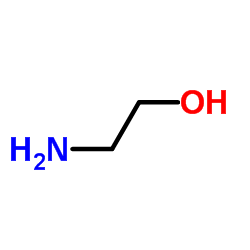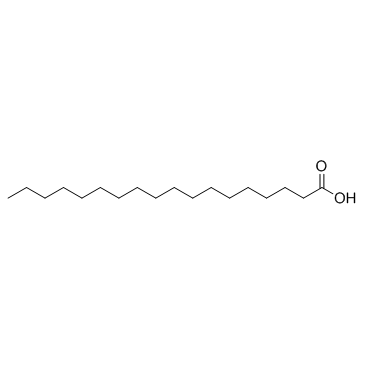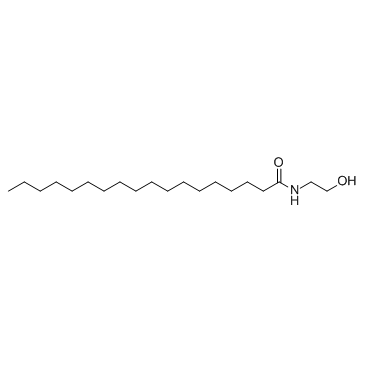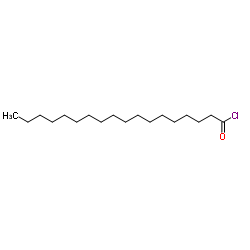2-[(1-oxooctadecyl)amino]ethyl stearate
![2-[(1-oxooctadecyl)amino]ethyl stearate Structure](https://image.chemsrc.com/caspic/043/14351-40-7.png)
2-[(1-oxooctadecyl)amino]ethyl stearate structure
|
Common Name | 2-[(1-oxooctadecyl)amino]ethyl stearate | ||
|---|---|---|---|---|
| CAS Number | 14351-40-7 | Molecular Weight | 594.00700 | |
| Density | 0.892g/cm3 | Boiling Point | 678.4ºC at 760mmHg | |
| Molecular Formula | C38H75NO3 | Melting Point | N/A | |
| MSDS | N/A | Flash Point | 364.1ºC | |
| Name | 2-(octadecanoylamino)ethyl octadecanoate |
|---|---|
| Synonym | More Synonyms |
| Density | 0.892g/cm3 |
|---|---|
| Boiling Point | 678.4ºC at 760mmHg |
| Molecular Formula | C38H75NO3 |
| Molecular Weight | 594.00700 |
| Flash Point | 364.1ºC |
| Exact Mass | 593.57500 |
| PSA | 58.89000 |
| LogP | 13.00910 |
| Vapour Pressure | 2.93E-18mmHg at 25°C |
| Index of Refraction | 1.463 |
| InChIKey | ZAYHEMRDHPVMSC-UHFFFAOYSA-N |
| SMILES | CCCCCCCCCCCCCCCCCC(=O)NCCOC(=O)CCCCCCCCCCCCCCCCC |
|
Section 1. Chemical Product and Company Identification Stearoyl Monoethanolamide Stearate Common Name/ Trade Name Stearoyl Monoethanolamide Stearate Section 4. First Aid Measures Check for and remove any contact lenses. In case of contact, immediately flush eyes with plenty of water for at least
Eye Contact 15 minutes. Get medical attention if irritation occurs. Wash with soap and water. Cover the irritated skin with an emollient. Get medical attention if irritation develops. Skin Contact Serious Skin ContactNot available. InhalationIf inhaled, remove to fresh air. If not breathing, give artificial respiration. If breathing is difficult, give oxygen. Get medical attention. Not available. Serious Inhalation Do NOT induce vomiting unless directed to do so by medical personnel. Never give anything by mouth to an Ingestion unconscious person. If large quantities of this material are swallowed, call a physician immediately. Loosen tight clothing such as a collar, tie, belt or waistband. Not available. Serious Ingestion Section 5. Fire and Explosion Data Flammability of the Product May be combustible at high temperature. Auto-Ignition Temperature Not available. Not available. Flash Points Not available. Flammable Limits These products are carbon oxides (CO, CO2), nitrogen oxides (NO, NO2...). Products of Combustion Fire Hazards in Presence of Slightly flammable to flammable in presence of heat. Various Substances Risks of explosion of the product in presence of mechanical impact: Not available. Explosion Hazards in Risks of explosion of the product in presence of static discharge: Not available. Presence of Various Substances SMALL FIRE: Use DRY chemical powder. Fire Fighting Media LARGE FIRE: Use water spray, fog or foam. Do not use water jet. and Instructions Not available. Special Remarks on Fire Hazards Not available. Special Remarks on Explosion Hazards Section 6. Accidental Release Measures Use appropriate tools to put the spilled solid in a convenient waste disposal container. Finish cleaning by spreading Small Spill water on the contaminated surface and dispose of according to local and regional authority requirements. Use a shovel to put the material into a convenient waste disposal container. Finish cleaning by spreading water on Large Spill the contaminated surface and allow to evacuate through the sanitary system. Stearoyl Monoethanolamide Stearate Section 7. Handling and Storage Keep away from heat. Keep away from sources of ignition. Ground all equipment containing material. Do not Precautions breathe dust. Keep away from incompatibles such as oxidizing agents. Keep container tightly closed. Keep container in a cool, well-ventilated area. Storage Section 8. Exposure Controls/Personal Protection Use process enclosures, local exhaust ventilation, or other engineering controls to keep airborne levels below Engineering Controls recommended exposure limits. If user operations generate dust, fume or mist, use ventilation to keep exposure to airborne contaminants below the exposure limit. Personal ProtectionSafety glasses. Lab coat. Dust respirator. Be sure to use an approved/certified respirator or equivalent. Gloves. Personal Protection in Case Splash goggles. Full suit. Dust respirator. Boots. Gloves. A self contained breathing apparatus should be used to avoid inhalation of the product. Suggested protective clothing might not be sufficient; consult a specialist BEFORE of a Large Spill handling this product. Exposure LimitsNot available. Section 9. Physical and Chemical Properties Solid. (Powdered solid. Crystalline powder.)Not available. Physical state andO dor appearance Not available. Taste 594.02 g/mole Molecular Weight White to yellowish. Color Not applicable. pH (1% soln/water) Not available. Boiling Point 84°C (183.2°F) - 86 C.(186.8 F.) Melting Point Not available. Critical Temperature Not available. Specific Gravity Not applicable. Vapor Pressure Not available. Vapor Density Not available. Volatility Not available. Odor Threshold Not available. Water/Oil Dist. Coeff. Not available. Ionicity (in Water) Not available. Dispersion Properties Insoluble in cold water, hot water. Solubility Section 10. Stability and Reactivity Data The product is stable. Stability Not available. Instability Temperature Conditions of Instability Excess heat, incompatible materials, sunlight Incompatibility with various Reactive with oxidizing agents. substances Not available. Corrosivity Stearoyl Monoethanolamide Stearate Protect from light. Special Remarks on Reactivity Not available. Special Remarks on Corrosivity Will not occur. Polymerization Section 11. Toxicological Information Inhalation. Ingestion. Routes of Entry Toxicity to AnimalsLD50: Not available. LC50: Not available. Chronic Effects on Humans Not available. Slightly hazardous in case of skin contact (irritant), of ingestion, of inhalation. Other Toxic Effects on Humans Not available. Special Remarks on Toxicity to Animals Not available. Special Remarks on Chronic Effects on Humans Acute Potential Health Effects: Special Remarks on other Skin: May cause skin irritation. Toxic Effects on Humans Eyes: May cause eye irritation. Inhalation: May cause respiratory tract irritation. Ingestion: May be harmful if swallowed. Section 12. Ecological Information Not available. Ecotoxicity Not available. BOD5 and COD Products of Biodegradation Possibly hazardous short term degradation products are not likely. However, long term degradation products may arise. The product itself and its products of degradation are not toxic. Toxicity of the Products of Biodegradation Not available. Special Remarks on the Products of Biodegradation Section 13. Disposal Considerations Waste DisposalWaste must be disposed of in accordance with federal, state and local environmental control regulations. Section 14. Transport Information Not a DOT controlled material (United States). DO T Cl assi fi cati on Not applicable. Identification Not applicable. Special Provisions for Transport Stearoyl Monoethanolamide Stearate DO T (Pi ctograms) Section 15. Other Regulatory Information and Pictograms No products were found. Federal and State Regulations California prop. 65: This product contains the following ingredients for which the State of California has found to California cause cancer which would require a warning under the statute: No products were found. Proposition 65 Warnings California prop. 65: This product contains the following ingredients for which the State of California has found to cause birth defects which would require a warning under the statute: No products were found. EINECS: This product is on the European Inventory of Existing Commercial Chemical Substances (EINECS No. Other Regulations 238-310-5). Canada: Listed on Canadian Domestic Substance List (DSL). China: Listed on National Inventory. Japan: Listed on National Inventory (ENCS). Korea: Not listed on National Inventory (KECI). Philippines: Not listed on National Inventory (PICCS). Australia: Listed on AICS. WHMIS (Canada) Not controlled under WHMIS (Canada). Other Classifications DSCL (EEC)This product is not classified according Not applicable. to the EU regulations. Health Hazard HMIS (U.S.A.)1 National Fire Protection 1 Flammability 1 Association (U.S.A.) Fire Hazard 1 0 Reactivity Health Reactivity0 Specific hazard Personal Protection E WHMIS (Canada) (Pictograms) DSCL (Europe) (Pictograms) TDG(Canada) (Pictograms) ADR (Europe) (Pictograms) Protective Equipment Gloves. Stearoyl Monoethanolamide Stearate Lab coat. Dust respirator. Be sure to use an approved/certified respirator or equivalent. SECTION 16 - ADDITIONAL INFORMATION N/A |
| HS Code | 2924199090 |
|---|
|
~% ![2-[(1-oxooctadecyl)amino]ethyl stearate Structure](https://image.chemsrc.com/caspic/043/14351-40-7.png)
2-[(1-oxooctade... CAS#:14351-40-7 |
| Literature: Journal of the Indian Chemical Society, , vol. 73, # 2-3 p. 123 - 128 |
|
~% ![2-[(1-oxooctadecyl)amino]ethyl stearate Structure](https://image.chemsrc.com/caspic/043/14351-40-7.png)
2-[(1-oxooctade... CAS#:14351-40-7 |
| Literature: Journal of the Chemical Society, Perkin Transactions 1: Organic and Bio-Organic Chemistry (1972-1999), , p. 373 - 377 |
|
~% ![2-[(1-oxooctadecyl)amino]ethyl stearate Structure](https://image.chemsrc.com/caspic/043/14351-40-7.png)
2-[(1-oxooctade... CAS#:14351-40-7 |
| Literature: Journal of the Chemical Society, Perkin Transactions 1: Organic and Bio-Organic Chemistry (1972-1999), , p. 373 - 377 |
|
~% ![2-[(1-oxooctadecyl)amino]ethyl stearate Structure](https://image.chemsrc.com/caspic/043/14351-40-7.png)
2-[(1-oxooctade... CAS#:14351-40-7 |
| Literature: Journal of Lipid Research, , vol. 51, # 1 p. 42 - 52 |
|
~% ![2-[(1-oxooctadecyl)amino]ethyl stearate Structure](https://image.chemsrc.com/caspic/043/14351-40-7.png)
2-[(1-oxooctade... CAS#:14351-40-7 |
| Literature: Journal of the Chemical Society, Perkin Transactions 1: Organic and Bio-Organic Chemistry (1972-1999), , p. 2197 - 2200 |
| HS Code | 2924199090 |
|---|---|
| Summary | 2924199090. other acyclic amides (including acyclic carbamates) and their derivatives; salts thereof. VAT:17.0%. Tax rebate rate:13.0%. . MFN tariff:6.5%. General tariff:30.0% |
| UNII-L3WR6PEQ9J |
| 2-[(1-oxooctadecyl)amino]ethyl stearate |
| 2-(stearoylamino)ethyl stearate |
| Cerasynt M/D |
| Octadecanoic acid,2-((1-oxooctadecyl)amino)ethyl ester |
| distearoylethanoylamine |
| 2-((1-oxooctadecyl)amino)ethyl ester |
| Stearamide MEA stearate |
| Stearic monoethanolamide stearate |
| 2-Stearamidoethylstearat |





 CAS#:88097-26-1
CAS#:88097-26-1